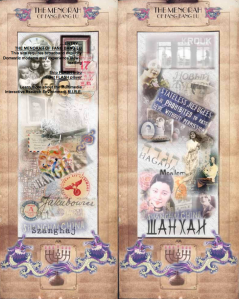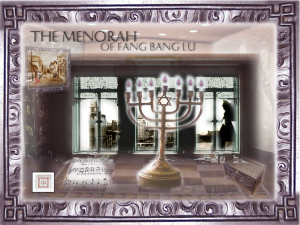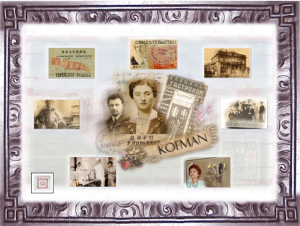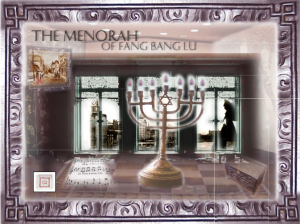Explore The Menorah of Fang Bang Lu online documentary
The Menorah of Fang Bang Lu presented/exhibition by Prof Andrew Jakubowicz, China Cultural Centre Sydney http://www.cccsydney.org 2015 in association with Jewish Refugees and Shanghai Exhibition. Curated as an installation in Crossroads: Shanghai and the Jews of China, Curator Jane Wesley, Sydney Jewish Museum, and, Carnivale, Performance Space, 2001. Creative Director, Tatiana Pentes and multimedia designer. Reviewed by Keth Gallasch RealTime issue #46 Dec-Jan 2001. Read online
VECTORS: Journal of Culture & technology in a Dynamic Vernacular
Issue 1. Winter, 2005 http://vectors.usc.edu/projects/index.php?project=40
“What can a single artifact tell us about history? For an archaeologist schooled in deciphering subtle traces, a lone relic can speak volumes. So it is with the 19th century brass menorah at the center of Andrew Jakubowicz’s The Menorah of Fang Bang Lu. Serving as a metaphor for the intertwining stories of four Jewish families living in Shanghai in the late 19th and early 20thcenturies, this object also provides evidence of a community that has since disappeared from the city, having joined the worldwide Jewish diaspora during World War II, only to make their way to Australia. Their stories are told and this history is pieced together through interviews with surviving family members and collections of photographs, documents and testimonies that describe a strikingly similar set of experiences. Jakubowicz’s exhaustively documented site offers a model for constructing a multi-perspectival portrait of a moment from the past that cannot be otherwise reconstituted. The family stories that constellate around the image of the menorah describe a set of common themes emerging from individual experiences with immigration, community and participation in an economic system. At the same time, the stories remain separate and distinct, a subtle evocation of the fact that none of the families knew each other when living in Shanghai; it is only through this reconstruction after the fact that their lives have been woven into a larger historical narrative. As a piece of historical evidence whose origins can only be conjectured, the menorah also functions as a metaphor for Jakubowicz’s investigation. The graceful folk tune that emanates from the music box in the base of the menorah is at once familiar and indecipherable, some of the notes having been long since worn away, but leaving enough of the tune intact to provide a suggestive starting point for historical enquiry. Like the films of Hungarian Peter Forgacs, who constructs historical narratives out of home movies shot by WWII era European Jewish families, Jakubowicz’s work resonates with traditions of oral history and history-from-below, implicitly arguing that the stories of “ordinary” people should not be excluded from the historical record.”
— Professor Tara McPherson and Steve Anderson
Division of Critical Studies, School of Cinematic Arts,
University of Southern California, Los Angeles, CA
SYNOPSIS
“The Menorah of Fang Bang Lu is a brass menorah (a Jewish religious candelabra), probably dating from the late nineteenth century. It was found on a second hand stall in a Shanghai antique market, in October 2000, more than forty years after the last Jews had left Shanghai. In its base is a wind-up music box, playing out a tune that has yet to be identified. Its simple chords evoke the many cultures of Jewish China. The antique market stands near the main entrance gate to Fang Bang Lu (or Fong Pang Road as it was known when there was a Jewish community in Shanghai from the 1840s to the 1950s). Fang Bang Lu is the main street in the old Chinese city (just south of the former French Concession and International Settlement), and leads to a tea house the original that has haunted western fantasies of China since the eighteenth century.
This computer based project explores the patterns that seven Australian families to Shanghai, families whose paths crossed many times, but who never met there. These four families will be joined by three more over the coming months – their lives entered through the flames of the Menorah. Through common themes of arrival, community, economy, place, interactions with China and the Japanese occupiers, and then the tenuous journeys to Australia, we begin to sense the intertwining of serendipity and design that mark their pathways. From the Moalems, key figures in the Sephardic (Babylonian/Spanish) religious community, to the Krouks, active participants in the vibrant Russian Jewish community, the Gunsbergers, surprising survivors of Kristallnacht and an escape across Europe to Manchuria, to the Weyland Jakubowicz family in their arduous struggle through the USSR and Japan, we begin to understand the rich fabric of cultural heritage of these diasporic people, who came at last as refugees to Australia. We discover the stories of Leisl Rosner (Gerber), a girl from Vienna who became a woman in Shanghai, Rachel Kofman, a Russian woman from Harbin who returned to China from her studies in California, and settled in Shanghai, and the Szekeres, mathematicians living in limbo on the edge of the world. The arrival of all these families in Australia from 1946 was in circumstances of hostility that are not overwhelmingly different from those facing today’s refugees and tells us much about not only where they came from but what they found in the new land.
Writer/ Producer: Andrew Jakubowicz is Professor of Sociology at the University of Technology Sydney; his parents arrived in Australia via Shanghai in 1946 most of their families had perished in the Holocaust. He now works in the area of multicultural affairs, and was the executive producer of Making Multicultural Australia a multimedia documentary (1999).
Creative Director: Tatiana Pentes, a multimedia designer who created the AMY award winner (2000) Strange Cities, an interactive digital work built around memories of Shanghai in the 1930s and 1940s, and the music of her grandfather, Shanghai orchestra leader Sergei Ermolaeff (Serge Ermoll), a Harbin born Manchurian Russian.”





